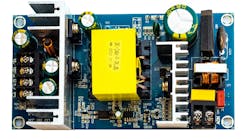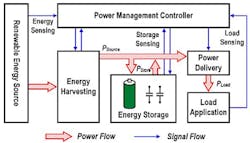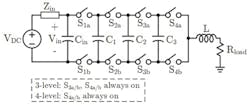Members can download this article in PDF format.
What you’ll learn:
- The importance of switched-capacitor power-density systems.
- What's the difference between resonant and hybrid switched-capacitor converters?
Lightweight, small-size, and high-power-density power converter systems, which use only switches and capacitors in their power stage, have no need for transformers or inductors in their design. This leads to ideal power supplies for mobile electronic systems like cell phones, personal digital assistants, and more.
Switched-capacitor (SC) converters have a large voltage-conversion ratio by design. These kinds of high-efficiency converter systems promise to have an excellent response to such challenges in the 21st century, such as low EMI emissions and the capability to realize a steep step-down of the voltage. This large step-down is to 3 V, or even sometimes to a lower supply voltage for integrated circuits. Or it may involve the steep step-up of the voltage for the automotive industry as well as internet services in the telecom industry.
Switched-Capacitor Power Circuitry
The SC converter is probably the most relevant contribution of the Circuits and Systems (CAS) Society to power electronics.
Switching-mode converters have the characteristics of light weight, small size, and high power density. These kinds of converters only employ switches and capacitors in their power stage.
One of the main applications of a switching-mode power converter is electronic mobile systems like personal digital assistants (PDAs), cell phones, and other related devices. To achieve such goals, the system power/energy management must play a forceful role.
Figure 1 shows that to improve energy efficiency, along with extending the run times, the load application, including function modules like radio, processor, memories, and sensors, will need to operate on an ultra-low-power budget.
In the table below, the minimum supply voltage (VDD) for IoT nodes will drop below 1.62 V to 0.5 V or even less in the future.
By 2027, it’s predicted that ideal IoT nodes would achieve record lows in power and cost while consuming just a mere 10 µW/MHz for a processor and 1 to 2 mW for radios, along with an achievable low overall cost of 50 cents and under.
Resonant vs. Hybrid Switched-Capacitor Converters
Let’s analyze the reactive power processed via the passive components of hybrid SC converters operating in the resonant mode. We will optimize and express the total passive component volume of the resonant switched-capacitor (ReSC) converter.8
To compare various ReSC topologies, a normalized passive volume parameter can be proposed for a fair, simple comparison. Let’s take the normalized passive volume parameter in conjunction with a normalized switch stress parameter (that’s based on the VA switch ratings), which can be helpful to compare and visualize the active and passive component uses in different topologies. This will offer a framework that compares the relative performance for those various kinds of topologies.
Typically, such designs have many floating switches, along with flying capacitors, that can lead to design circuitry challenges. Many charge-pump and bootstrap-based techniques can supply gate-drive power to the floating switches in an efficient and compact way.
As compared to conventional isolated DC-DC power-supply ICs, these proposed circuits will consist of a simple structure and operating principle. This circuitry can be implemented with a minimum number of capacitors, diodes, and low-dropout (LDO) regulators, leading to far less occupied board space area plus lower utilization cost.
How to Achieve Flying-Capacitor Voltage Balancing
The next key area to address is flying-capacitor voltage balancing. In any unbalanced operations, capacitor voltages will typically deviate from their nominal values, potentially leading to system failure. Designers can experimentally investigate the causes of this kind of voltage imbalance in practical applications with flying-capacitor multilevel (FCML) converters in addition to current analogous solutions.9
FCML converters can achieve high power density along with high efficiency thanks to the effective application of low-voltage switches and passive components. They’re able to naturally balance capacitor voltages via phase-shifted pulse-width modulation. In practice, capacitor voltages may still deviate; however, active balancing will often be required.
An FCML converter with an even number of levels typically offers much better capacitor balancing than one with an odd number of levels. That’s due to the best possible built-in immunity to any circuit non-idealities. Figure 2 illustrates a configurable 3/4/5-level FCML buck power converter.
In an N-level FCML converter operating with phase-shifted pulse-width modulation (PSPWM), the (N−1) pairs of switches turn on and off with a phase shift of 360/(N−1) degrees, and the corresponding (N−2) flying capacitors have voltage ratings of VDC/(N−1), 2VDC/(N−1) ... (N−2)VDC/(N−1), respectively. Because the switch voltage stress is defined as the difference between the voltages of adjacent capacitors, each switch will have an ideal voltage rating of VDC/(N−1).
This reduced switch voltage rating is a key advantage of such multilevel converters. Nevertheless, a common practical implementation issue, similar to FCML converters, is the capacitor voltage imbalance. This capacitor voltage describes the scenario in which the capacitor voltages will deviate from their nominal values because of various disturbances—it will result in an increase in the drain-source voltage stress across those switches. Designers can prevent switch failures by using over-rated switches for an extra margin of safety, accompanied by performance penalties.
Designers will want to keep capacitor voltages inside a desired set of bounds. The capacitor voltages, or the inductor current, may be monitored and must be actively controlled by changing the switching patterns to selectively charge or discharge one or more of the flying capacitors.
PSPWM Self-Balancing Property
The methods discussed above may be difficult to apply to FCML converters that have a high number of levels, high switching frequency, and low capacitor values because of the high bandwidth sensing and control needed, in addition to the extra area overhead. In preference, FCML converters are able to rely on the natural balancing property of the PSPWM scheme.
Therefore, the natural balancing property declares that the capacitor voltage imbalance will lead to an increase in the inductor ripple current. This, in turn, will lead to power dissipation in the series resistance of the circuit so that the capacitors are able to be incrementally charged/discharged toward their nominal voltages.
This self-balancing property can offset the unfavorable effect of the non-idealities and disturbance in the circuitry when the disturbance is small. In the past, the focus was on the mechanics of the self-balancing property and the dynamics of the capacitor voltages given a step input. Nevertheless, the sources of disturbance to the capacitor voltages haven’t yet been broadly investigated.
To have confidence in the natural balancing property in FCML converters, it’s imperative to understand the physical origins of the non-idealities that are responsible for the capacitor voltage imbalance. In turn, they can be discarded or reduced via design.
Simpler Power Boost with SC Converters
The switched-capacitor converter eliminates the need for the burdensome and/or costly inductors that boost voltage. The SC converter relies only on the capacitors to achieve voltage boosting, which will enable a higher power density. The usefulness of monolithic integration, together with low EMI and simple control, makes the SC voltage regulator an attractive power solution for the IoT.
References
1. “A 48-to-12 V Cascaded Resonant Switched-Capacitor Converter for Data Centers with 99% Peak Efficiency and 2500 W/in3 Power Density,” Zichao Ye, Yutian Lei, and Robert C. N. Pilawa-Podgurski, IEEE 2019.
2. “DC-DC Converter With Low Input Current Ripples in Hybrid Switched Capacitor and Boost Topology,” Robert Stala, Szymon Folmer, Zbigniew Waradzyn, 2021 IEEE 19th International Power Electronics and Motion Control Conference (PEMC).
3. “Performance Evaluation and Analysis for Resonant Switched Capacitor Converter,” Mengxuan Weia, Ze Nib, Shuai Yanga, Maohang Qiua, Xiaoyan Liua Dong Caoa, IEEE 2021.
4. “A 48-to-12 V Cascaded Resonant Switched-Capacitor Converter Achieving 4068 W/in3 Power Density and 99.0% Peak Efficiency,” Ting Ge, Zichao Ye, Rose A. Abramson and Robert C.N. Pilawa-Podgurski, 2021 IEEE Applied Power Electronics Conference and Exposition (APEC).
5. “Switched Capacitor Based Voltage Boost Converter for Electric Vehicle Applications,” K. P. Suresh, R. Senthil kumar, C. Kathirvel, N.Karthic Balaji, V.S.Ajith Kumar, N. Agathiyanathan, 2021 7th International Conference on Advanced Computing and Communication Systems (ICACCS).
6. Switched-Capacitor Power Electronics Circuits, Adrian Ioinovici.
7. “State-of-the-Art Monolithic Switched-Capacitor Voltage Regulators for Ultra-Low Power Internet of Things,” Kang Wei, D. Brian Ma, Integrated Power System Laboratory, IEEE 2018.
8. “Hybrid Switched-Capacitor Power Converters: Fundamental Limits and Design Techniques,” Zichao Ye, Electrical Engineering and Computer Sciences University of California, Berkeley, December 1, 2021.
9. “Investigation of Capacitor Voltage Balancing in Practical Implementations of Flying Capacitor Multilevel Converters,” Zichao Ye, Yutian Lei, Zitao Liao, Robert C.N. Pilawa-Podgurski, IEEE 2017.




